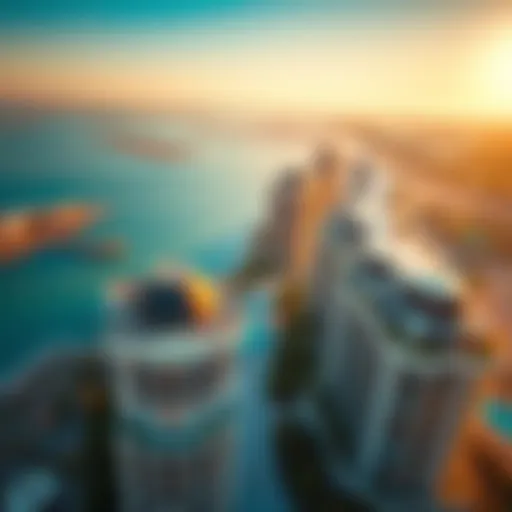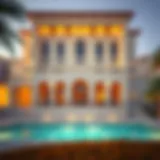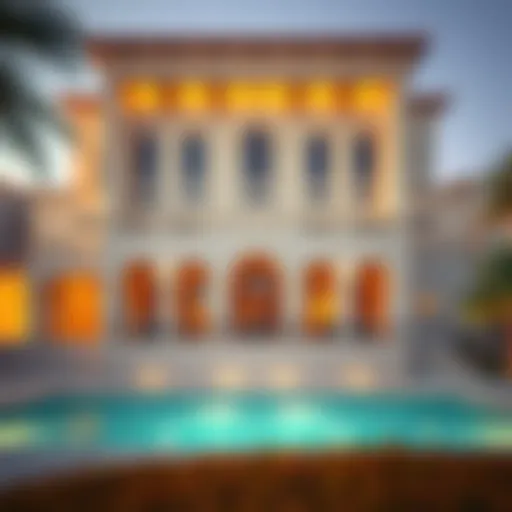Exploring Arabic Villa Design: Culture & Aesthetics


Intro
The architectural landscape in Dubai is like a vibrant tapestry interwoven with threads of history, culture, and modernity. Among the striking designs that stand proudly against the skyline, Arabic villas stand out not only for their aesthetic appeal but also for their cultural significance. These villas are much more than mere dwellings; they are a reflection of the rich heritage and traditions that define the region.
As a melting pot of cultures, Dubai's evolution as a contemporary metropolis has transformed the way we perceive villa designs. However, the essence of Arabic architectural elements remains unwavering, anchoring these constructions to their historical roots.
The journey through Arabic villa design encompasses various layers—from the intricate carvings on stucco walls to the lush gardens embraced by tranquil water features. Every detail speaks volumes about the traditions and values of the Arab culture, making the exploration of these designs not just a visual feast but a narrative of identity and history.
In this piece, we will delve into the intricate aspects of Arabic villa design, examining the longstanding influences that have shaped these structures, and how modern interpretations are making waves in the real estate market.
There’s a growing interest in understanding how sustainable practices and contemporary amenities are being seamlessly incorporated into the traditional designs, creating spaces that are not only beautiful but functional. Let’s embark on this enlightening journey through culture and aesthetics.
Intro to Arabic Villa Design
The realm of Arabic villa design offers a fascinating lens through which to view a rich tapestry of culture and art. These villas are not just residences; they are reflections of centuries of history, tradition, and artistic innovation. Understanding this design isn’t merely an academic exercise; it is crucial for anyone wishing to engage deeply with the real estate terrain in places like Dubai, where modernity entwines seamlessly with heritage.
This section aims to lay the groundwork for the exploration of Arabic villa design by delving into its defining characteristics, as well as its historical context and the evolution that has shaped what we see today. Such an understanding not only enriches appreciation but also enhances decision-making for real estate investors, expatriates, homebuyers, and landlords who navigate this vibrant market.
Defining Arabic Villa Architecture
Arabic villa architecture often conjures images of grand spaces adorned with intricate details. These structures typically feature expansive courtyards and lavish gardens, blending seamlessly with nature. They stand as symbols of luxury and sophistication, characterized by spaciousness and an emphasis on outdoor living. Notably, the Arabic villa often showcases considerable regional variations influenced by local culture and climate.
Common elements include:
- Arched doorways and windows: These not only serve an aesthetic purpose but also help in naturally cooling the space.
- Decorative screens (Mashrabiya): These wooden lattice-work screens blend artistry with gender segregation, allowing air to flow while maintaining privacy.
- Vibrant tilework: With roots in Islamic art, the colorful mosaics bring life and energy to spaces, merging functional flooring with stunning designs.
In essence, Arabic villa architecture embodies both the spirit of its cultural roots and the demands of contemporary living, making it an ever-evolving art form.
Historical Context and Evolution
The history of Arabic villas is deeply entwined with the socio-political fabric of the regions they adorn. Originating in the deserts and oases, these dwellings reflect a lifestyle dictated by the climate, resource availability, and societal norms. Initially designed for practicality rather than opulence, early constructions focused primarily on sustainability and comfort.
As trade routes expanded during the flourishing of early Islamic civilization, influences from Persian, Roman, and later European architecture seeped into Arabic designs. This exchange ushered in an era where ornamentation became increasingly elaborate, setting the stage for the villas as we recognize them today.
Significant historical milestones include:
- The Umayyad and Abbasid periods which led to some of the earliest forms of luxuriously adorned villas in places like what is now Syria and Iraq.
- The Mamluk and Ottoman influences that introduced new artistic traditions, notably in tilework and calligraphy.
With the arrival of modernism in the 20th century, villa design began to navigate the tension between preserving traditional aesthetics and embracing contemporary styles. This evolution makes Arabic villa architecture not just a static legacy, but a living tradition that adapts and thrives against the backdrop of modern growth, specifically within the buzzing metropolis of Dubai.
Cultural Influences in Design
The realm of Arabic villa design is a vibrant tapestry woven from diverse cultural influences. These elements not only represent aesthetic preferences but also encapsulate the historical and spiritual narratives of the region. Verdant gardens, intricate tile work, and stunning calligraphy are not just embellishments; they echo centuries of tradition and embody cultural significance that resonates deeply with the identity of the space.
The importance of understanding cultural influences in design cannot be overstated. For real estate investors and homebuyers alike, this knowledge sheds light on the intrinsic value of properties. Distinctive elements stemming from Arabic heritage can elevate a villa's appeal, combining functionality with a rich storytelling aspect, which in turn can increase property value. Appreciation of these influences also allows buyers to forge a deeper connection with their homes, making investments not merely financial decisions but also personal ones.
Integration of Islamic Art


Islamic art plays a profound role in Arabic villa design, serving as a reflection of faith and the surrounding environment. This art form is characterized by intricate geometric patterns, calligraphy, and nature-inspired motifs. It often adorns everything from wall tiles to ceilings, creating a sense of unity and harmony within the space.
For instance, Mashrabiya, the traditional latticework, is not just a decorative feature; it was originally designed to provide privacy while allowing air circulation. This practical application of art exemplifies how aesthetics can serve everyday needs, bridging beauty with functionality.
Some key considerations regarding the integration of Islamic art include:
- Authenticity: Maintaining the originality of designs while respecting cultural contexts.
- Versatility: Blending traditional motifs with contemporary designs for a fresh perspective.
- Environmental Considerations: Using sustainable methods and materials that align with Islamic principles.
Incorporating Islamic art into villa design fosters an cultural dialogue that enhances the living experience.
Symbolism in Architectural Features
Symbolism is another predominant aspect of Arabic villa design, infusing the structure with deeper meaning. Architectural features often convey messages about nobility, hospitality, and introspection. For example, the grand entrance typically signifies welcome and openness, while courtyards often reflect tranquility and peace.
Numerous architectural elements are laden with symbolism:
- Domes: Represent spiritual elevation and connection to the divine.
- Arches: Signify strength, innovation, and beauty, serving both practical and aesthetic purposes.
- Water Features: Often symbolize purity and life, acting as a calming focal point in the outdoor landscape.
In this way, each element is purposefully crafted to evoke an emotional response, allowing dwellers to engage with their surroundings on a spiritual level. The deliberate integration of symbolic features amplifies the overall experience of living in an Arabic villa, making it more than just a dwelling but a sacred space that narrates a broader story.
Elements of Villa Design
In the realm of Arabic villa design, the elements that come together form a symphony of tradition and modernity. These elements not only define the aesthetic value of a villa but also signify the cultural undertones embedded in these architectural wonders. Understanding the significance of these elements can offer investors and homebuyers invaluable insights when entering the real estate market of Dubai and beyond.
Traditional Materials and Construction Methods
The foundation of any villa lies in its materials and construction techniques. Arabic villas often showcase locally sourced materials, which resonate with the cultural and environmental context of their surroundings. Traditional materials such as mud bricks, clay tiles, and stone hold historical weight and reflect a time when sustainability was a necessity rather than a trend.
Using local materials fosters a sense of belonging and continuity in design. For instance:
- Adobe bricks, employed for their thermal mass, keep homes cool during Dubai's scorching summers.
- Carved stone, often used in columns and facades, tells stories of artisans who once chiseled these intricate designs by hand.
This emphasis on traditional construction methods serves practical purposes, too. Homes built with these materials are generally more resilient to the elements.
Use of Arches and Decorative Screens
Arches are not just architectural statements; they are symbolic in Arabic culture. These curved structures embody grace and strength, often found in the doorways and windows of villas. The beauty of arches lies in their versatility and function. They allow natural light to flood the interiors while providing cool shadows—an essential feature in hot climates.
Decorative screens (or mashrabiya), another defining feature, add an air of privacy while still enabling airflow. These intricately carved wooden screens are not merely for decoration; they serve to filter sunlight and retain the cool breeze essential to comfort in the heat.
- The interplay of light and shadow through these screens creates stunning visual effects inside the villa, enhancing its ambiance.
- The delicate designs often tell stories—flowers, geometric patterns, or verses from poetry that resonate deeply with cultural heritage.
Outdoor Spaces and Landscaping
Outdoor areas in Arabic villas are crafted as extensions of the interior. These spaces serve as serene retreats that blend the beauty of nature with luxurious living. Gardens, courtyards, and terraces are thoughtfully designed to accommodate gatherings or quiet contemplation.
The landscaping often includes:
- Water features like fountains, which not only provide aesthetic beauty but also an inviting sound of 'flowing water', symbolizing life and prosperity.
- Low-maintenance flora like palms and aromatic shrubs thrive in the region's climate while adding color and fragrance to the environment.


These outdoor elements create an experience that is both visually appealing and culturally rich. A villa's outdoor space becomes synonymous with hospitality, where family and friends can gather in a setting steeped in warmth and tradition.
"In Arabic culture, the home is an extension of one’s identity; thus, every element crafted within and around it holds a story that transcends generations."
As potential investors or homebuyers reflect on these core aspects, they can better appreciate the depth and significance behind Arabic villa design, making more informed decisions in a competitive real estate landscape. The intersection of traditional craftsmanship and modern sensibilities will invariably shape the narrative of future developments in this vibrant region.
Interior Design in Arabic Villas
Interior design in Arabic villas is much more than just aesthetics; it goes beyond the surface to encapsulate intricate cultural traditions, rich history, and a hospitable essence. As these villas play a central role in the lives of their inhabitants, the interior layout, decor, and environment need to be considered carefully. Through thoughtful design, these spaces reflect the values and rituals of Arabic culture, creating a warm atmosphere that invites both family and guests alike.
Color Palettes and Furnishings
When it comes to interior design, color palettes in Arabic villas are a symphony of rich tones and textured fabrics. Warm hues such as deep reds, earthy browns, and vibrant yellows create an inviting ambiance. Ornate textiles, often handwoven, contribute not only to visual appeal but also to cultural heritage.
These colors stem from the natural environment of the region—think golden sands and the azure sky. Such shades tend to evoke feelings of warmth and hospitality. A color like terracotta, often seen in local pottery, can influence the rest of the design, complementing furniture choices ranging from traditional low seating known as majlis to plush contemporary couches.
The furnishings in Arabic villas often combine practicality with a narrative. For instance, a large wooden table might act as a focal point for gatherings while also carrying intricate carvings reflecting Islamic art. Each piece varies in motif, often rich in symbols that convey stories or local folklore, thus adding another layer to the narrative of the home.
Lighting and Ambiance
Lighting plays a pivotal role in shaping the atmosphere in Arabic villas. Traditional sources of light, such as lanterns and intricate sconces, not only illuminate but also cast beautiful shadows, enhancing the decorative elements around them. The type of lighting creates an interplay between light and dark, which can shift the overall mood from serene and intimate to vibrant and social depending on the occasion.
In more modern settings, the blend of natural and artificial light can be utilized effectively. Large windows framed with delicate drapes, allow natural light to flood communal spaces during the day. During evening gatherings, strategically placed LED lights in warm hues can simulate the glow of a fire, adding a cozy and inviting feel to the environment.
Decorative Arts and Artifacts
The decorative arts within Arabic villas are vibrant expressions of local artistry and culture. Artifacts play a significant role—they are not mere ornaments but pieces steeped in significance. Handcrafted ceramics, intricate mosaic work, and traditional calligraphy often grace the walls, serving as conversation starters among guests. These artifacts are typically sourced from local artisans, fostering a sense of community and preserving traditional craftsmanship.
In many Arabic homes, you will find artifacts such as Arabic coffee pots, traditional rugs, and ornate mirrors that hold cultural significance. Each piece not only adds beauty but is imbued with meaning, telling tales of the past and the values held dear in the community.
"Art is not what you see, but what you make others see." - Edgar Degas
This profound saying reflects the purpose of interior design in Arabic villas—creating spaces that evoke emotion and narrate a history that is not just personal but also collective.
For further insights on Arabic architecture, consider visiting resources such as Britannica, or explore local culture on discussion forums like Reddit.
Modern Interpretations of Arabic Villas
Modern interpretations of Arabic villas signify a pivotal shift in architectural concepts and styles. These modifications are not merely cosmetic but rather profound adjustments that encapsulate the evolving lifestyle of people living in vibrant regions like Dubai. With the intertwining of traditional aesthetics and contemporary design elements, these interpretations aim to enhance the functionality of spaces while retaining the rich cultural heritage of Arabic architecture. This section will elaborate on these pivotal aspects, highlighting the unique elements and considerations that come into play in the evolving landscape of villa design.
Fusion of Contemporary and Traditional Styles
The fusion of contemporary and traditional styles in Arabic villas creates an unparalleled architectural narrative. Architects and designers often find innovative ways to marry the grandeur of past forms with the sleekness of modern design principles. For instance, open floor plans are a hallmark of modern architecture, promoting fluidity and interaction within spaces. Yet, this is beautifully complemented by traditional Arabic elements, such as intricate mashrabiya screens or ornamental arches, which add depth and character to the designs.
- Advantages of This Fusion:
- Key Considerations:
- Enriches spatial experiences while providing a dialogue between past and present.
- Encourages a unique identity for newly constructed homes, giving them a sense of timelessness.
- Attracts a broader audience, from young expats to families seeking cultural resonance in their living spaces.


- Ensuring that the integration does not strip away the authenticity of traditional designs.
- Employing sustainable materials that echo both modern standards and traditional craftsmanship.
By carefully balancing these influences, architects create residences that reflect the community’s ethos while addressing the demands of modern life. In the bustling context of a city like Dubai, capturing this essence can make all the difference in real estate desirability.
Sustainability in Modern Designs
As global awareness of environmental concerns heightens, the aspect of sustainability in modern Arabic villa designs has gained significant traction. Incorporating sustainable practices doesn't simply mean adopting modern technology; it's about revisiting ancient techniques and harmonizing them with innovation for a greener footprint. Such an approach sees the inclusion of energy-efficient solutions like solar panels, water recycling systems, and natural ventilation pathways.
- Key Elements of Sustainable Design:
- Local Materials: Using materials sourced close to the construction site reduces transportation emissions and supports local economies.
- Orientation and Layout: Thoughtful designs that maximize natural light minimize reliance on artificial lighting, while strategically placed windows can enhance ventilation, reducing the need for air conditioning.
- Green Spaces: Incorporating gardens or green roofs not only enriches the aesthetic but also promotes biodiversity.
"Sustainable design is not a trend; it is a necessity for the future of humanity, reflecting our responsibility toward the environment."
In summary, the incorporation of sustainable practices into modern Arabic villa designs influences not only the architectural landscape but also promotes a holistic approach to living that respects both cultural heritage and the environment. Real estate investors and potential homeowners should look for these features, as they represent a forward-thinking mindset that adds both value and significance to properties in today’s market.
Case Studies: Iconic Arabic Villas
Examining iconic Arabic villas offers valuable insights into the architectural richness and cultural essence that define this unique style of design. Each villa represents more than just a residence; they embody the history, beliefs, and evolving tastes of their communities. By delving into specific examples, we can better appreciate how traditional elements harmonize with contemporary needs, resulting in dwellings that speak to both heritage and innovation.
Analyzing Notable Examples
Take for instance the renowned Sheikh Mohammed bin Rashid Al Maktoum's private residence in Dubai, which artfully blends traditional Arabic architecture with modern luxury. The villa showcases intricate mashrabiya screens, enabling privacy while allowing natural light to filter through in soft patterns. The expansive exterior courtyard welcomes guests into a serene space filled with lush gardens and water features— a nod to classic Arabic design philosophies that encourage outdoor living and connectivity with nature.
Another sterling example is the Qasr Al Watan, located in Abu Dhabi. This presidential palace is not merely a governmental building; it is a stunning testament to Islamic artistry and culture. The dome, standing at an impressive height of 37 meters, is a marvel of engineering, while the use of white granite and intricate marble mosaics reflect exquisite craftsmanship. Such structures communicate the importance of heritage in modern identities, serving both functional and aesthetic roles within society.
Lessons Learned from Architectural Masterpieces
From these case studies, several key lessons emerge about the future trajectory of Arabic villa design:
- Blending Styles: Mixing traditional elements with modern aesthetics can result in timeless beauty. The fusion doesn't have to compromise authenticity; rather, it can enhance it by rendering spaces more livable.
- Sustainability Matters: Iconic villas often incorporate sustainable practices in their design. For instance, utilizing local materials and designs that promote natural cooling align with environmental goals, reflecting a growing awareness toward ecological impact.
- Space and Layout: Open layouts that facilitate movement and social interaction are pivotal. They encourage community and family bonding, which are central to Arabic culture.
"Architecture should speak of its time and place, but yearn for timelessness."
Thus, these masterful examples of Arabic villas not only represent individual statements of luxury but also embody broader cultural narratives. By analyzing these villas, real estate investors, expatriates, and homebuyers alike can glean insights into what makes these spaces truly exceptional—encouraging a deeper connection to their architectural and cultural elements.
As the landscape of property investment continues to evolve, understanding the past and present of Arabic villa design will be crucial for navigating the complexities of the market, particularly in a vibrant city like Dubai.
Epilogue: The Future of Arabic Villa Design
As we take a step back and reflect on the intricate architecture of Arabic villas, the journey does not end here. Instead, it paves the way for a future that balances tradition with innovation. Understanding where this design ethos is headed is essential not just for architects and designers, but also for investors and homeowners interested in the evolving landscape of property. The future holds much promise, aligning deeply-rooted aesthetics with the demands of modern living.
Balancing Tradition and Innovation
In any culture, architecture serves as a bridge between history and contemporary life. For Arabic villa design, the challenge lies in preserving the cultural identity while catering to the needs and preferences of today’s inhabitants. Villa designs increasingly showcase a hybrid model—traditional features such as intricate tile work and calligraphic motifs can be subtly infused with sleek lines and open spaces that cater to modern sensibilities.
Modern technologies like sustainable building materials and energy-efficient systems are gaining traction, allowing for a smoother integration of innovation without sacrificing aesthetic integrity. The unique embroidery of cultures, both ancient and new, underscores how Arabic villa design can evolve yet stay true to its roots.
"Architecture is the art of how to waste space."
Philip Johnson
Influence on Dubai's Property Market
Dubai serves as a dynamic canvas for architectural innovation, deeply influenced by the region's cultural narrative. As the property market in Dubai continues to flourish, the design and aesthetics of Arabic villas play a crucial role in attracting investors and homebuyers alike. Luxury villas that nod to the richness of Arabic heritage are seen as valuable commodities, appealing to both expatriates and affluent locals.
The integration of high-class amenities with traditional aesthetics positions these villas in a unique marketplace. Investors are beginning to recognize that properties that respect local culture tend to hold their value better, providing a nice buffer against market fluctuations. Additionally, developments emphasizing environment-friendly practices garner positive public attention, thus impacting real estate dynamics as eco-conscious buyers seek homes that reflect their values.















